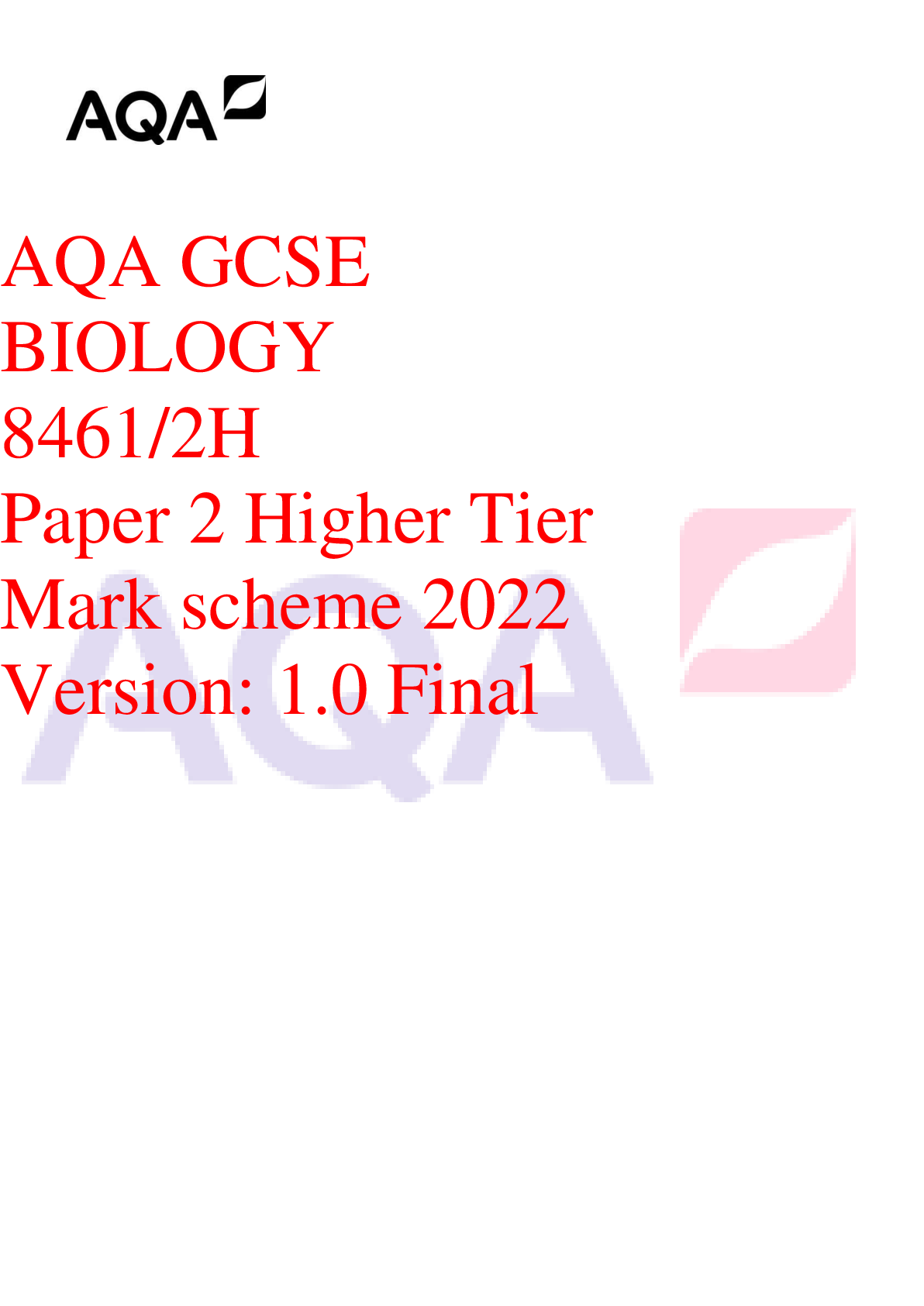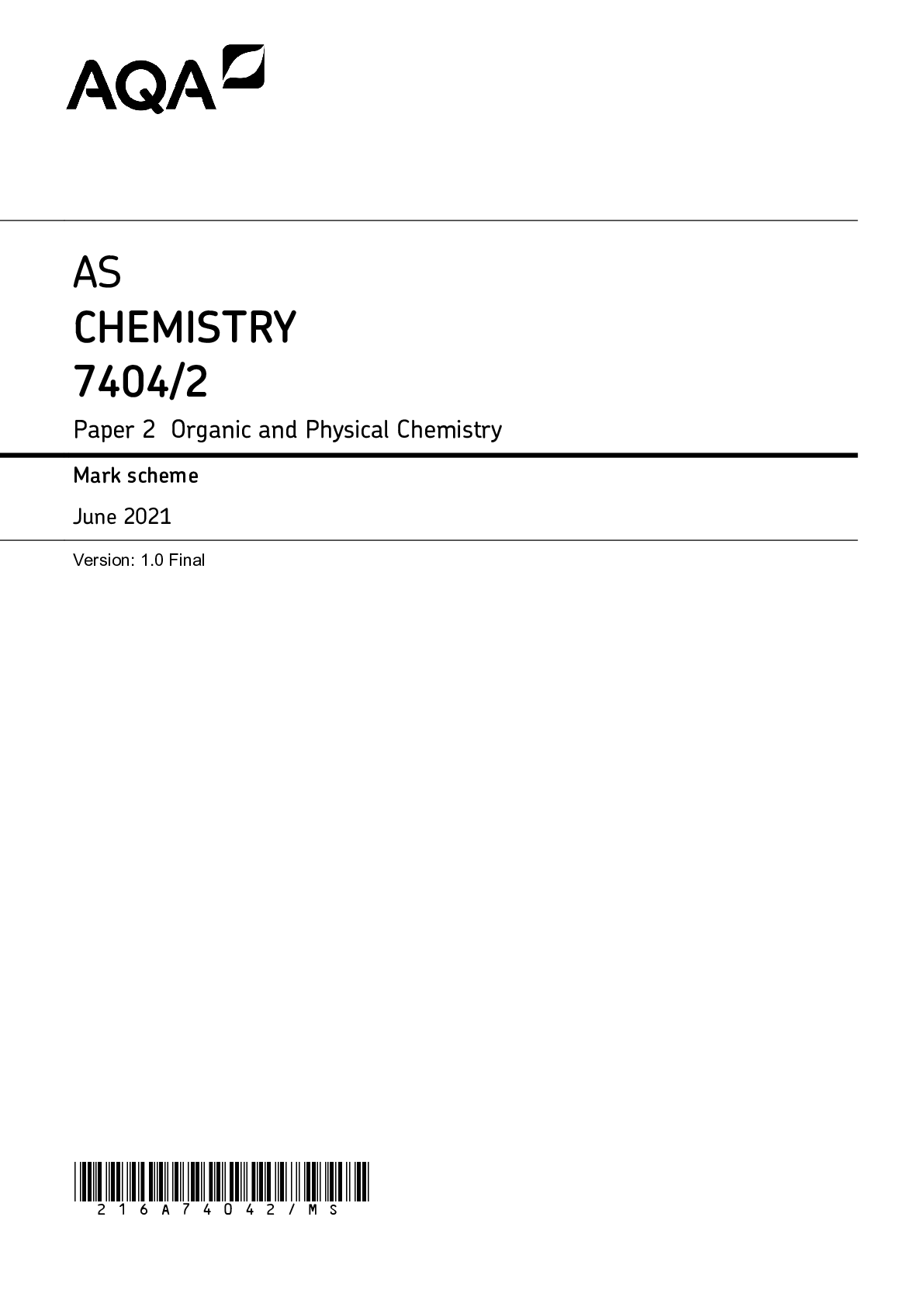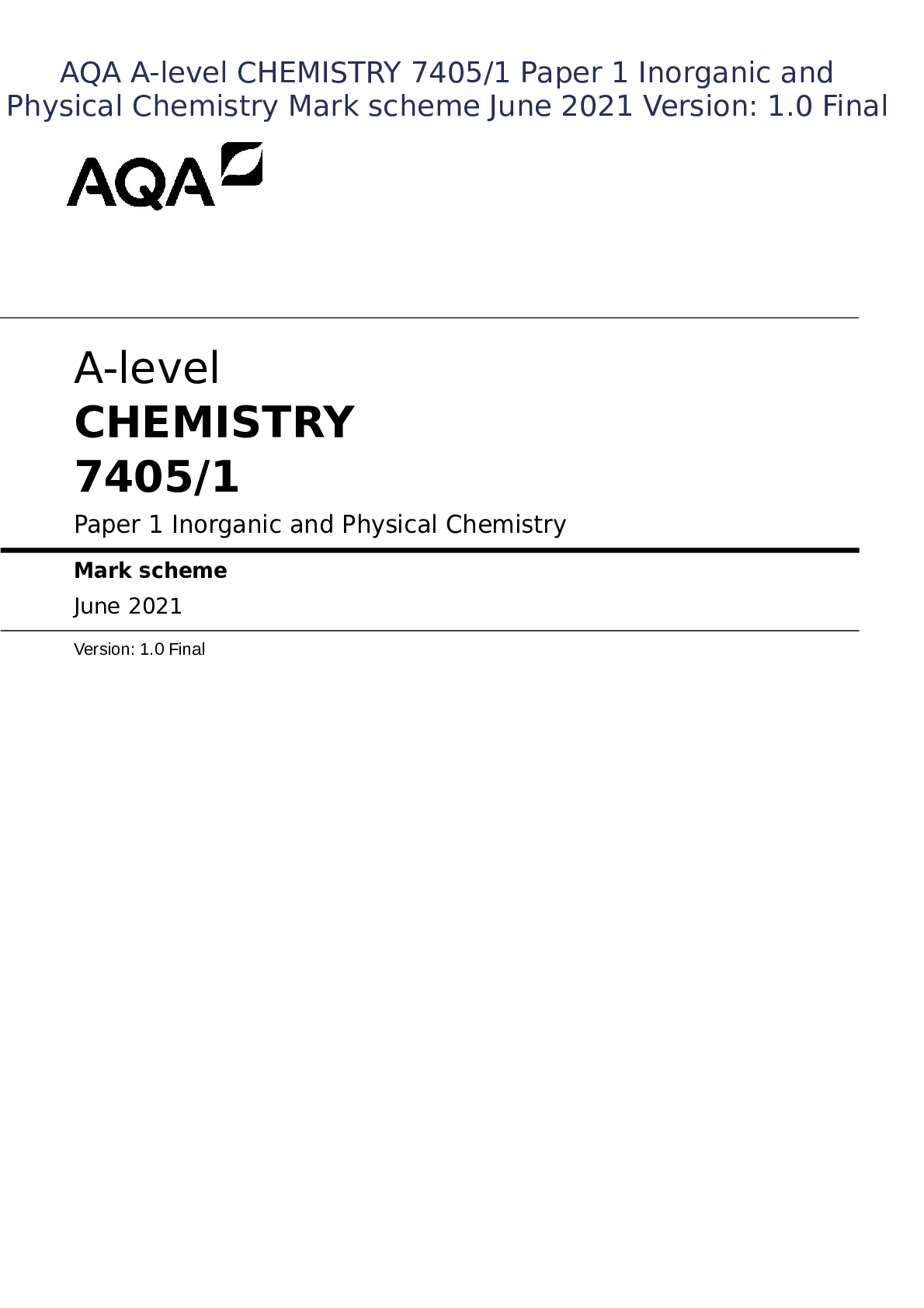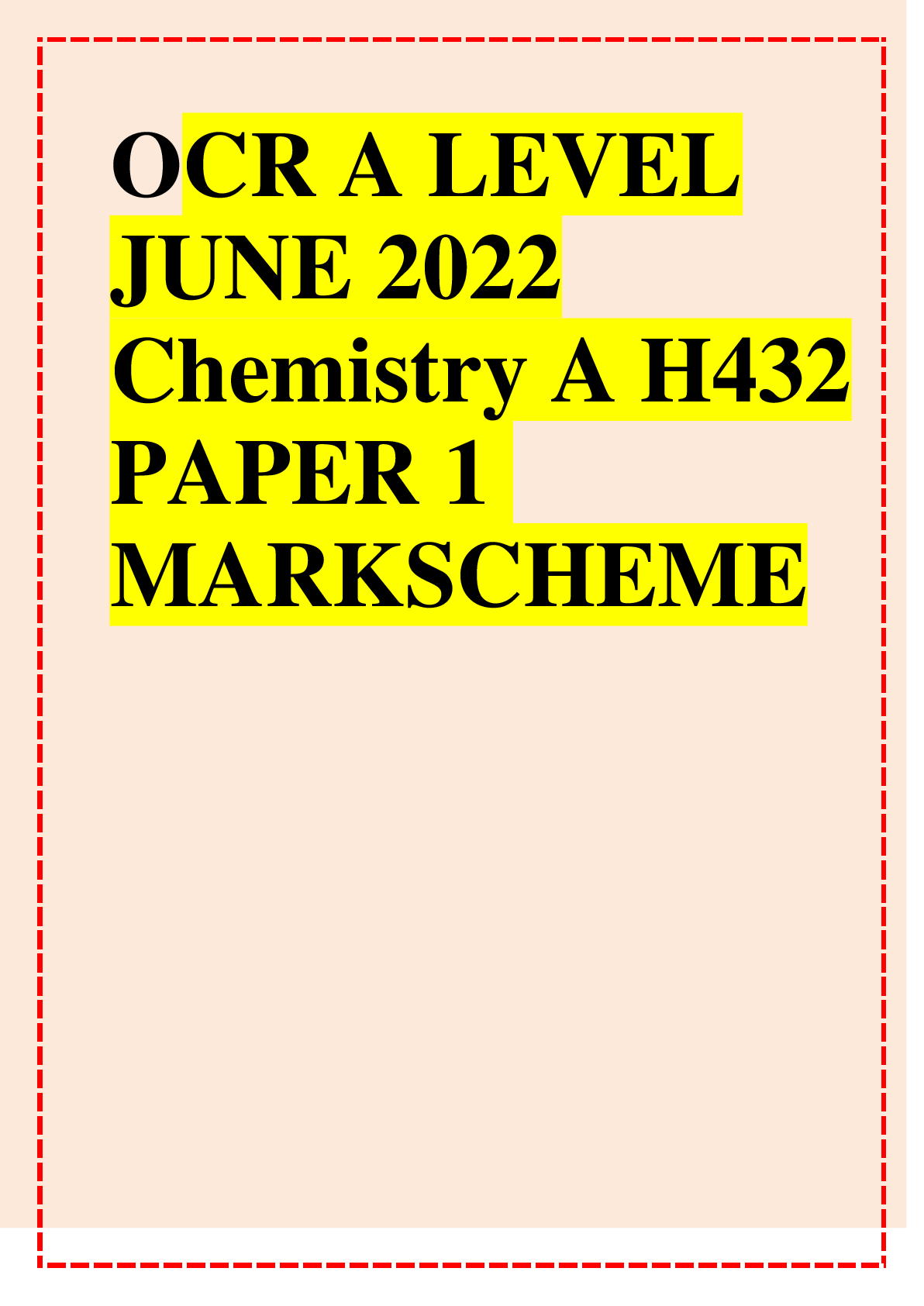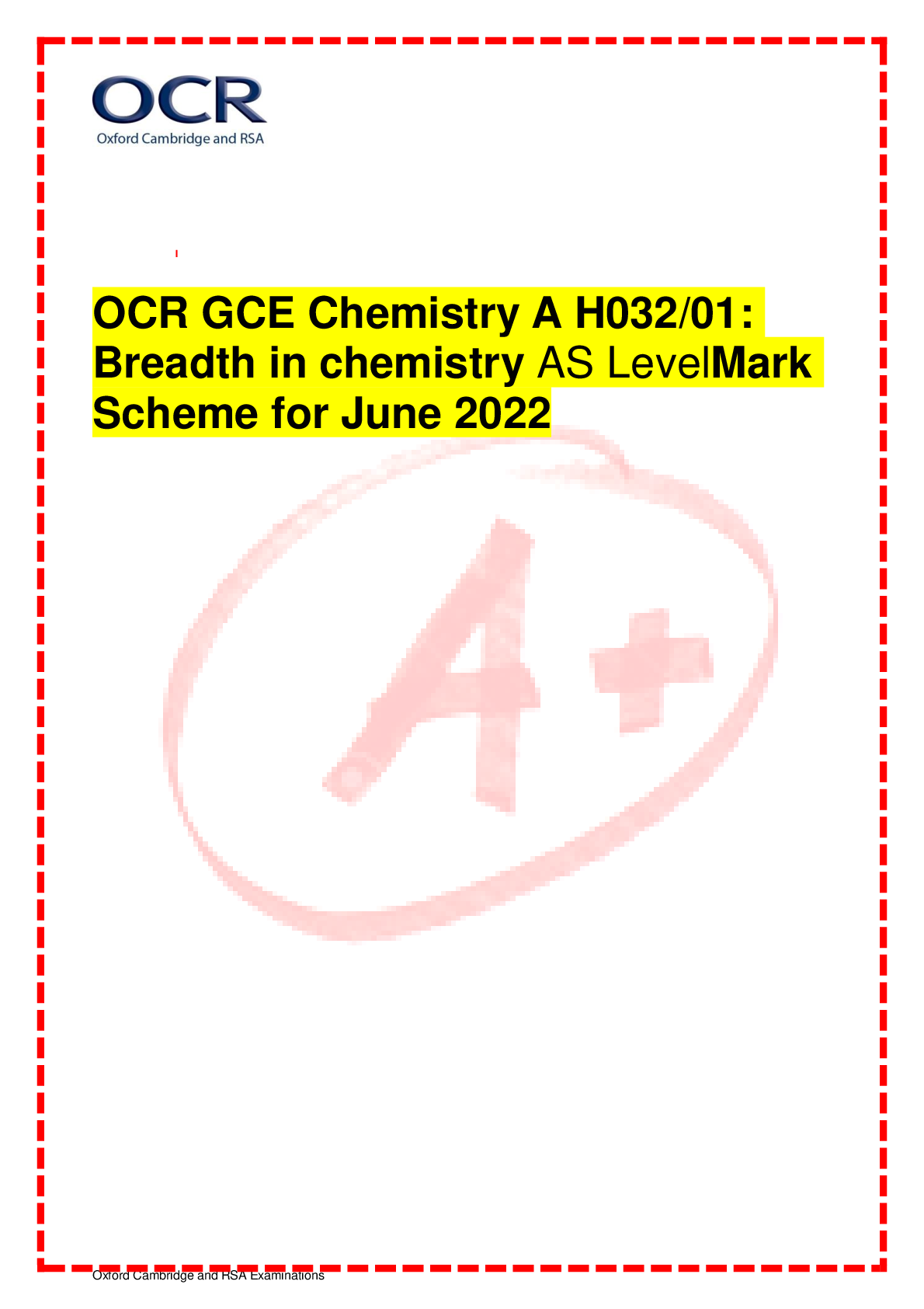Health Care > AS Mark Scheme > OCR June 2022 – Morning/Afternoon A Level Chemistry A H432/03 Unified chemistry SAMPLE MARK SCHE (All)
OCR June 2022 – Morning/Afternoon A Level Chemistry A H432/03 Unified chemistry SAMPLE MARK SCHEME
Document Content and Description Below
OCR June 2022 – Morning/Afternoon A Level Chemistry A H432/03 Unified chemistry SAMPLE MARK SCHEME MAXIMUM MARK 70 MARKING INSTRUCTIONS PREPARATION FOR ... MARKING SCORIS 1. Make sure that you have accessed and completed the relevant training packages for on-screen marking: scoris assessor Online Training; OCR Essential Guide to Marking. 2. Make sure that you have read and understood the mark scheme and the question paper for this unit. These are posted on the RM Cambridge Assessment Support Portal 3. Log-in to scoris and mark the required number of practice responses (“scripts”) and the required number of standardisation responses. YOU MUST MARK 10 PRACTICE AND 10 STANDARDISATION RESPONSES BEFORE YOU CAN BE APPROVED TO MARK LIVE SCRIPTS. MARKING 1. Mark strictly to the mark scheme. 2. Marks awarded must relate directly to the marking criteria. 3. The schedule of dates is very important. It is essential that you meet the scoris 50% and 100% (traditional 50% Batch 1 and 100% Batch 2) deadlines. If you experience problems, you must contact your Team Leader (Supervisor) without delay. 4. If you are in any doubt about applying the mark scheme, consult your Team Leader by telephone, email or via the scoris messaging system. 5. Work crossed out: a. where a candidate crosses out an answer and provides an alternative response, the crossed out response is not marked and gains no marks b. if a candidate crosses out an answer to a whole question and makes no second attempt, and if the inclusion of the answer does not cause a rubric infringement, the assessor should attempt to mark the crossed out answer and award marks appropriately. 6. Always check the pages (and additional objects if present) at the end of the response in case any answers have been continued there. If the candidate has continued an answer there then add a tick to confirm that the work has been seen. 7. There is a NR (No Response) option. Award NR (No Response) - if there is nothing written at all in the answer space - OR if there is a comment which does not in any way relate to the question (e.g. ‘can’t do’, ‘don’t know’) - OR if there is a mark (e.g. a dash, a question mark) which isn’t an attempt at the question. Note: Award 0 marks – for an attempt that earns no credit (including copying out the question). 8. The scoris comments box is used by your Team Leader to explain the marking of the practice responses. Please refer to these comments when checking your practice responses. Do not use the comments box for any other reason. If you have any questions or comments for your Team Leader, use the phone, the scoris messaging system, or email. 9. Assistant Examiners will send a brief report on the performance of candidates to their Team Leader (Supervisor) via email by the end of the marking period. The report should contain notes on particular strengths displayed as well as common errors or weaknesses. Constructive criticism of the question paper/mark scheme is also appreciated. 10. For answers marked by levels of response: Read through the whole answer from start to finish, concentrating on features that make it a stronger or weaker answer using the indicative scientific content as guidance. The indicative scientific content indicates the expected parameters for candidates’ answers, but be prepared to recognise and credit unexpected approaches where they show relevance. Using a ‘best-fit’ approach based on the science content of the answer, first decide which set of level descriptors, Level 1, Level 2 or Level 3, best describes the overall quality of the answer using the guidelines described in the level descriptors in the mark scheme. Once the level is located, award the higher or lower mark. The higher mark should be awarded where the level descriptor has been evidenced and all aspects of the communication statement (in italics) have been met. The lower mark should be awarded where the level descriptor has been evidenced but aspects of the communication statement (in italics) are missing. In summary: • The science content determines the level. • The communication statement determines the mark within a level. Level of response questions on this paper are 2(a) and 4(d). 11. Annotations Annotation Meaning DO NOT ALLOW Answers which are not worthy of credit IGNORE Statements which are irrelevant ALLOW Answers that can be accepted ( ) Words which are not essential to gain credit Underlined words must be present in answer to score a mark ECF Error carried forward AW Alternative wording ORA Or reverse argument 12. Subject-specific Marking Instructions INTRODUCTION Your first task as an Examiner is to become thoroughly familiar with the material on which the examination depends. This material includes: • the specification, especially the assessment objectives • the question paper • the mark scheme. You should ensure that you have copies of these materials. You should ensure also that you are familiar with the administrative procedures related to the marking process. These are set out in the OCR booklet Instructions for Examiners. If you are examining for the first time, please read carefully Appendix 5 Introduction to Script Marking: Notes for New Examiners. Please ask for help or guidance whenever you need it. Your first point of contact is your Team Leader. Question Answer Marks Guidance 1 (a) Bromine has stronger/more induced dipole interactions OR temporary dipole interactions OR London forces 1 ALLOW van der Waals’ forces OR intermolecular forces (b) Hydrogen bonds in ice hold H2O molecules further apart (than in water) 1 (c) Potassium (atoms) have one more proton (than argon) 1 (d) Further substitution occurs 1 ALLOW multiple substitution occurs ALLOW examples of further substitution products (e) 1 dm3 water has a mass of 1000 g n(H2O) in 1 dm3 = 1000 56 mol 18 1 (f) π bonds in benzene are delocalised 1 (g) Carboxylic acids have a broad O–H absorption at 2500–3300 (cm–1) (which ketones do not) 1 ORA (h) pV (100 103) (1.00 10–3) n = RT = 8.314 400 = 0.0301 mol 1 AW n(N2O) = 1.323 / 44.0 = 0.0301 mol AND mass of N2O = 0.0301 44.0 = 1.323 g V = 0.0301 8.314 400 = 1.00 103 m3 100 103 (= 1.00 dm3) Requires evidence of use of ideal gas equation AND M(N2O) = 44.0 (i) M(C6H5COOCH3) = 136 g mol1 1 Answer needs evidence of the 4.25, 136 and Question Answer Marks Guidance 4.25 × 6.02 × 1023 = 1.88 x 1022 136 6.02 × 1023 being used correctly (j) The C–Br bond is weaker (than the C–Cl bond) 1 ORA Total 10 Question Answer Marks Guidance 2 (a)* Please refer to the marking instructions on page 4 of this 6 Indicative scientific points may include: Use one sample for cation test, other sample for anion tests Details of tests Cation test add Aqueous sodium hydroxide Positive observations • for Mn2+ : pink/buff precipitate • for Fe2+ : green precipitate • for NH + : litmus paper held over the opening 4 of the tube turns blue Fine detail: • (gentle) heating for NH + test 4 Equations: Mn2+ + 2OH– Mn(OH)2 Fe2+ + 2OH– Fe(OH)2 NH + + OH– NH + H O 4 3 2 Anion tests CO 2–: 3 • add nitric acid; positive observation: effervescence SO 2–: 4 • add aqueous barium nitrate; positive observation: white precipitate Cl–: • add silver nitrate solution; positive observation: white precipitate Fine detail for Cl–: mark scheme for guidance on how to mark this question. Level 3 (5–6 marks) Develops a plan that allows identification of all six ions AND includes essential detail and equations for all test procedures and observations, with three anion tests in the correct sequence, CO 2–, SO 2– then Cl– AND includes cation test with essential detail and all equations There is a well-developed, detailed plan which is clear and logically structured. The plan is substantiated with relevant information, e.g. justification of the sequence of anion tests. There is a clear explanation of how the observations allow the ions to be identified. Level 2 (3–4 marks) Develops a plan that allows identification of at least three ions AND includes detail of at least three test procedures and observations, and three equations There is an appropriate plan presented with some structure. Parts of the fine detail, correct sequence, or reference to use of both samples may be missing. There is some attempt to explain how the observations allow the ions to be identified. Question Answer Marks Guidance Level 1 (1–2 marks) Develops a plan that allows identification of at least two ions AND includes detail of at least two test procedures and observations, and one equation The plan is basic and communicated in an unstructured way. The response lacks fine detail and no reference to correct sequence of anion tests. There is little or no attempt to explain how the observations allow the ions to be identified. 0 marks No response or no response worthy of credit. • subsequent addition of dilute ammonia solution positive observation: precipitate dissolves. Fine detail: correct sequence of all three anion tests • carbonate test followed by sulfate test followed by halide test • justification of sequence • ALLOW splitting of solution over three boiling tubes/test tubes and performing each test on a different sample. Equations: CO 2– + H+ CO + H O 3 2 2 Ba2+ + SO 2– BaSO 4 4 Ag+ + Cl– AgCl (b) Kw value from graph from 2.2 to 2.4 × 10–14 (mol2 dm–6) 3 Actual Kw = 2.38 × 10–14 mol2 dm–6 Using 2.4 × 10–14, ALLOW ECF only if candidate uses a value [H+] = 24. 10 14 OR 1.55 × 10–7 between 2.0 and 2.6 × 10–14 (mol2 dm–6), i.e. from the approximately correct region of the graph pH = –log (1.55 × 10–7) = 6.81 (using Kw = 2.4 × 10–14) ALLOW 6.8 (1DP) up to calculator value ALLOW ECF only if candidate has generated a value of [H+] by attempting to take a square root of a value between 2.0 and 3.0 × 10–14 (c) (i) Co : N : H : Cl = 21.98 : 31.35 : 6.72 : 39.75 58.9 14.0 1.0 35.5 2 Question Answer Marks Guidance = 0.373 : 2.24 : 6.72 : 1.12 = 1 : 6 : 18 : 3 Formula = CoN6H18Cl3 (ii) [Co(NH3)6]3+ 1 Total 12 [Show More]
Last updated: 2 years ago
Preview 1 out of 11 pages

Buy this document to get the full access instantly
Instant Download Access after purchase
Buy NowInstant download
We Accept:

Reviews( 0 )
$12.00
Can't find what you want? Try our AI powered Search
Document information
Connected school, study & course
About the document
Uploaded On
Jan 10, 2023
Number of pages
11
Written in
Additional information
This document has been written for:
Uploaded
Jan 10, 2023
Downloads
0
Views
96

